Stephen Gusterson



I have a feeling I know the answer to this question before I begin.
Has anyone altered Chassis design to make provisions for doors? Does anyone think it's possible without greatly compromising the integrity of
the chassis? Ideas...Thoughts......Drawings??????
Two words
Stephen Gusterson 

I'm afraid I don't think the book chassis is going to cope mate as to get a door in, you'd have pretty much no sides!!! You could alter the design to have a solid roof area which would take the 'strain' as it were but then you won't have a seven anymore and would be designing a new car from scratch.
http://www.locostbuilder.co.uk
I am obviously wrong!!!
Nevermind!!!
you could have doors so long as you keep the 13 inch "sill". By doors I'm talking about permenant side screens.
The real problem is the width of a 7. your elbow prety much hangs outside the car. if you fit doors then you have nowhere to put your arm
I am considering half doors attatched to the scuttle. These would be cruved down from the top of the scuttle and ending just before your forearm
while resting your elbow on the side. Since I will be going with a raked /split windshield it may be possible to use lexan/polycarb to add a wrap
around wind deflector to the half doors that would blend right to the screen.
Dale
quote:
Originally posted by smart51
you could have doors so long as you keep the 13 inch "sill"
The real problem is the width of a 7. your elbow prety much hangs outside the car. if you fit doors then you have nowhere to put your arm
 at the amount of weight this would add but I'm building my car for the street, not track.
Aestetics are important as well as speed.
at the amount of weight this would add but I'm building my car for the street, not track.
Aestetics are important as well as speed.

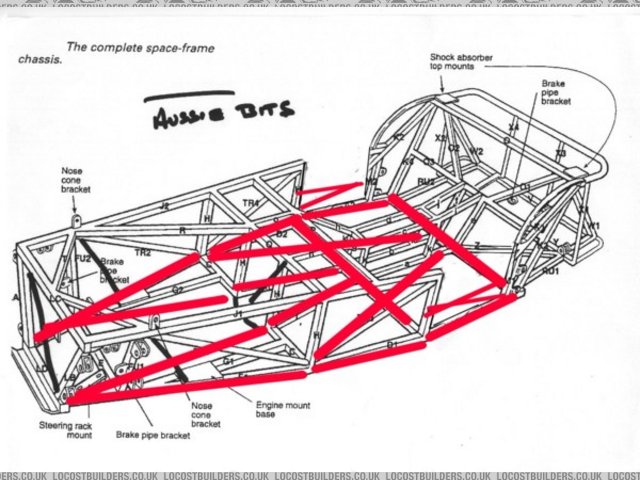
I would think that unless your going IRS you will need to make your sill a minimum as high as the upper trailing arm bolt. If not then under hard
acceleration you would cause damage.
Dale
How about if I used aluminum rear trailing arms off a triumph tr6? They just bolt directly into the lower chassis member, thus transferring the
stresses there.
No need to have the upper b-post mounts then.
Hello Jermyn,
I suggest you don't mess with the chassis around the sides of the cabin. Because the cabin , for obvious reasons, is an incomplete box, it is
already torsionally compromised, so you you want to keep as is. Moreover, the length of tube H in the book chassis is 11", add to that the
widths of tubes N1 and A1 (1" each), then add ride height (6" in the original Lotus 7, but most Locosters use 3.5 to 5" , and you have
at most 18", knee high to a grass hopper! I mean this 18" compares well with the height of the sill that you have to step over in a nornal
sedan. So, the door should, in my opinion, go ABOVE, the N1 tube.
, and you have
at most 18", knee high to a grass hopper! I mean this 18" compares well with the height of the sill that you have to step over in a nornal
sedan. So, the door should, in my opinion, go ABOVE, the N1 tube.
There are some nice implemntations of doors on sevenesque cars:
1. Look at Donkervoort, the Dutch makers. Google the name and then select the image function in Google to see examples. Briefly, what they did was
to have a hefty windscreen frame (it looks carbon fiber) analogous to an "A" pillar in a normal car. They then make a lightweight composite
door from this pillar. The door opens Countach-like. I think it looks pretty sexy, especially viewed from front when both doors open (sort of
Doberman-ear like).
2. The German maker RCB77 attaches doors in a conventional manner; these give the car a hot rod look; again not too shabby.
3. In the Champion book, bottom picture of page 182 is shown a design of a full rollover cage, that can take gull wing doors.
I am going to try to attch a couple of pics, but, since I have never done this before (see waht you got me into  ) it may or may not work.
) it may or may not work.
Good luck and keep the sketches coming.
Cheers
KT (in sunny Chicago)
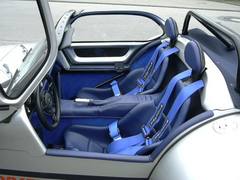

Rescued attachment donkervoort.jpg
Ha,
it worked, so here is the other one.
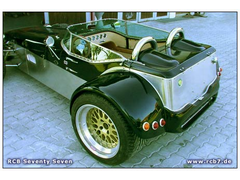

Rescued attachment rcb6_20l.jpg
I see what you mean about the height factor. and the H tube. My concern was weakening the chassis too much by removing that area.
I really like the first picture. Interesting how they use that snap-flap to keep the doors closed instead of some sort of internal latch system.
Thanks for the pics and the website info. I hadn't checked out the new Donkervorts. Most of the Seven books I own have older pics.
would building the doors to fit the open space snuggly with triangulation truely cause weakness?

Doors like that would stop the bending of the chassis but wouldn't restore the torsional rigidity as they are not connected. Also, if they fit
snuggly you wouldn't be able to open them since the chassis bending will clamp them in.
If you could open the doors then they will obviously not be doing anything structurally.
Liam
If you're having full bodywork over the chassis, could you not have largebox section sills - like a lotus elise? Something like 6x6 box section
suitably tied in to the rest of the chassis.
Liam
quote:
Originally posted by Liam
If you're having full bodywork over the chassis, could you not have largebox section sills - like a lotus elise? Something like 6x6 box section suitably tied in to the rest of the chassis.
Liam
I figured building a mix of a ladder frame and space frame will allow for the open door section. (if i decided to do the doors)
Developing a mix of the two applications in theory and testing them with models is not beyond my skill level. However, this method would not be
reliably accurate.
Realistically, they would need to be built or engineered through some sort of design/test program which I have no access to or knowledge about. Plus,
I'm not trying to spend 10 years designing a chassis just so I can have doors.
On the other hand, plenty of autos have been built on unreliable engineering ideas that have been successful. Space frame and ladder frames both have
benefits. Why not make them both work in a hybrid sort of chassis. Who's building a hybrid sort like this now?
I'd suggest a 4x2-14g (minimum size) sill replacing tubes D1/D2, A1/A2 and K3/K4.
Omit tubes TR5/6, N1/N2, M1/M2, K1/K2 to make way for the doors.
This will restrict footwell space a bit as the 4x2 is a lot chunkier than the book 1x1 tube so I'd suggest going the wide chassis route as in the
Mc Sorley plans.
Also the book trailing arm arrangement won't be possible with this mod. You could opt for a Westfield style rear double wishbone layout.
A live axle or Deon would be possible if you continued the 4x2 approximately where tubes W1/W2 are in the book which would give a solid pick up point
for upper leading arms. Lower links could be leading to give a "book backwards" layout (Marcos used to use this layout on the V8 Mantula
cars) or you could use two lower links going forwards from the axle ends angled inwards to meet the bottom of tubes e and f (which will need to be in
1x1, not 3/4x3/4, if you feed suspension loads into them). This will only work well if you can make the angle of the lower tubes to the axle line
greater than 30 degrees, probably only possible with swept back pickups on a Deon tube.
If this is compatable with your ideas then I'll plug the version of the above mods you decide on into my analysis and tell you what it does, or
doesn't do, for stiffness.
By the way, stiffening up the floor isn't going to help much if you cut out the side tubes.
Cymtriks,
I was thinking more along these lines. Mcsorley 442 chassis.
Omit N1, N2, TR6 and TR5.
Make A1, A2, B1, B2, H1 and H2 all 4x2.
X brace the box section with TR4 and TR3.
Move M1 and M2 Back to converge 90 degrees with B1.Make them 4x2 also
Change the angle of the lower sections of K1 and K2 to be more angled like TR5 and TR6. This will result in a slanted rear of the door but will
provide that needed triangulation.
What do you think about that?

sorry,
forgot to mention:
westfield-type dual wishbone rear suspension setup
Jermyn,
Check clearance for the gearbox, propshaft and diff with 4x2 tubes if you use this size for B1 and B2.
I think you've got the general idea, that you you need to carry the 4x2 tubes into the spaceframe a bit to make certain that the loads find their
way into the sills.
Any loads fed into the H1/2 tubes will have to go round a sharp corner, 90 degrees, to get into the sills which is why I chose to continue the 4x2
sill tubes along D1/2.
Regarding the rear of the doors how about having the sills run to tube B1 as you suggest and having a 4x2 tube going from the bottom of where tubes
M1/2 are to tube O. K3 and 4 then provide triangulation.
Regarding X bracing the TR3/4 positions you'd probably get the same result by increasing these tubes to 1 inch round or to 1 inch square.
Sounds like it might work Course, the whole thing might fold in half.
Course, the whole thing might fold in half.
Can you make the mods and plug it into your program? I'm really interested to see if it will work.
I've attached a picture.
By the way Liam is right. Big sills are best.
I put 4x2 14g (approx 100mm x 50mm 2mm wall) tube into the model as shown. The K3/4 tubes were so close to the seat back 4x2 tube that I've not
shown it in the picture, it didn't carry much load anyway whn I ran the model.
The biggest stresses turn out to be the tube bendiing sideways at the rear kink hence the side reinforcing plates and vertically at the door front
hence the top and bottom plates.
When you apply, admitedly always a guess, the suspension loads of 3g bump and a safety factor of two you are at the limits of the tubes. I've
suggested some reinforcements in the picture.
As a comparison many Cobra replicas are made of 4x2 but with 1/8 inch wall (a bit more than 3mm). So a typical Cobra chassis has just over 50% thicker
walled tubes and the finished car weighs a bit over 50% more. And Cobra chassis handle 5.7 liter engines with over 400 bhp which is about triple a
typical locost.
The stiffness was 1150ftlbs per degree compared to 1180 for the book chassis. The weight estimate was 199 lbs compared to the book chassis of 181 lbs
(16g floor in steel). So it's a bit heavier and very slightly less stiff.
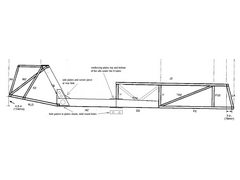

Rescued attachment locostdoors.jpg
Looks good. I'm thinking I will try to build some balsa wood models
Anyone fancy that idea instead?

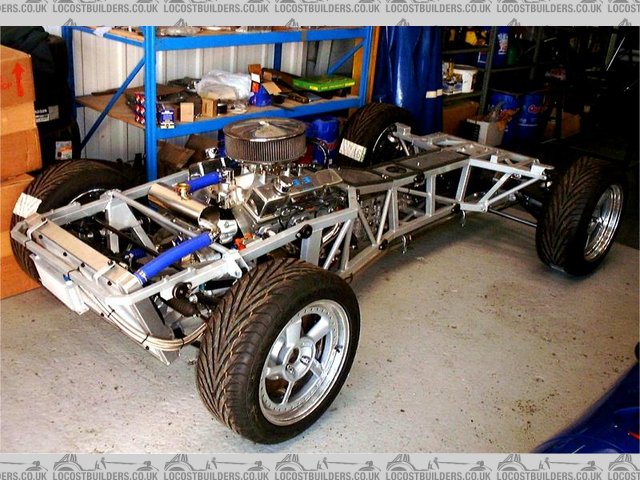
Rescued attachment CHASSI_03.jpg
Without tortional rigidity numbers, the above chassis is an unknown. *If* the top, bottom, and both sides of the transmission tunnel have riveted
panels, it could be pretty good.
[Edited on 3/5/05 by kb58]
As a novice, I had a hard time figuring out rusiq's design.
When it clicked I was truly impressed with his innovative thinking - depending on what the experts say I may copy it.
That chassis is a GD cobra and according to their website has 2750 ftlbs per degree of twist. Though it doesn't say if this is with or without
the body fitted.
This is more than twice the book Locost but it has to support about half as much again in weight and a lot more in power. It is very similar in
stiffness to my suggested double Y braced Locost chassis.
The only weakness of the design is the bend in the top chassis tube as it goes round the back of the engine.
The original Elan wasn't far off this design but didn't need a bent tube to get round its much smaller straight four engine. The result was
4000 ftlbs per degree.
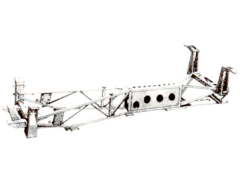

Rescued attachment spacef2.gif
See these: www.spydercars.co.uk


Rescued attachment CB-3a.jpg
And the Lotus Elan chassis is not a spaceframe chassis. It is a backbone chassis.

If doors are a requirement, then compromises have to be made. I'd suggest you even look at a ladder style chassis. Though not as rigid as a
space frame, they can be made very light and rigid enough to be a very good street car. It worked for Henry Ford for over 40 years.
Take a look at this hot rod chassis with IFS and a three link and envision an X-brace to stiffen it more and a Locost body over it (with doors). It
gives you a lot of options to add doors, customize bodywork, and install the drivetrain and suspension.

For the naysayers who have never built an American style hot rod with a box steel ladder chassis, this 2x4 steel frame is stronger than it looks! The
one pictured here will easily handle far more horsepower than our delicate little Locust space frame! A 300hp track roadster is a very potent little
car! Move the passenger compartment rearward and extned the hoodline, and the proportions end up very similar to a Locost.
Most roadsters built in this fashion (small block chevy) end up weighing much more than a Locust, about 1600 lbs, but with a lighter drivetrain and
rear end could weigh hundreds less. These are usually somewhat larger than a Locust as well, with a wheelbase of around 100", so it could also
be scaled down for more weight savings.

quote:
Originally posted by MustangSix
For the naysayers who have never built an American style hot rod with a box steel ladder chassis, this 2x4 steel frame is stronger than it looks!
Having actually built and driven a couple of similar rods, I can tell you that they definitely do NOT twist that easily. The last one I owned, a 28
Ford roadster, would easily lift the left front wheel, but the right front wheel would accompany it! An exciting ride, to say the least! Again,
300 hp, 1800 lbs.
Again,
300 hp, 1800 lbs.
Torsional rigidity is very good on most properly constructed street rods. It's actually very necessary. A stock early Ford chassis is so flexy
that doors can pop open and if you used glass bodywork, you'd be fighting cracks in no time. On my 28 and the 34 before that, the chassis was
stiff enough that those were never issues. The torsional rigidity comes from the fact that the main members are thick wall tubes themselves. Any
chassis twist has to be translated into a twist onto the main rails, and a 2x4 .125" thick tube is hard to twist, I assure you.
I would probably say that the picture above is probably not the best example of stiffness, though. you can do better. That's why my rods
incorporated an X-member on the 34 and a K-member in the 28 to reduce chassis flex. Is it as rigid as a space frame? Likely not, but unless you
intend to go road racing, a box tube ladder is more than stiff enough (and far stiffer than Henry's originals) for a street car. I won't
argue that for some purposes, the space frame is superior.
A properly constructed space frame would be lighter and stiffer. But as I said, if doors are needed, compromises must be made. I think in that case
I would prefer a tried and true ladder design to a highly modified Locust book-chassis space frame. Not that I'd ever convince any of you
fellow Locost disciples. 
Read all the posts.
Has anybody considered gull wing doors.
I have come up with 2 ideas for these that would be quite feasable.
1:solid framed or formed lexan sheet.
2:Fabric (leatherette) roll up.
Both supported by an overhead central tube running from the top of the windscreen surround to the top of the rollbar tube.
Any comments ???
They should work fine, though I don't see how they would allow for a stiffer chassis. The doors will intrude into the chassis as much as the space needed to squeeze through them, regardless of where the hinges are.
I think the formed lexan doors wouldn't be a bad idea. Although, if you were adding doors which you really wanted to function and make the car
more liveable in incelment weather, you might as well just make some real ones from steel, or alum.
It wouldn't be a huge deal to put a dip of a few (or several? ) inches in the outer sill in order to make room for a hard door.
You would lose some stiffness, sure, but a tremendous amount? A mushier chassis may help forgive poor shock/spring/anti-roll tuning and keep all 4
tires on the road, I'm not encouraging this, just throwing it out there. just ask Carroll Shelby, the AC cobra chassis was so floppy that this
was the exact case.
[Edited on 26/3/05 by turbo time]
There's always following the JP's (Sylva) thinking with the Stylus

Good heavens that's a monster; I'd put on much larger rear tires. As it is I'd guess you'd have wheel spin "on demand" all the way up to around 100mph....
quote:
Originally posted by MustangSix
Is it as rigid as a space frame? Likely not, but unless you intend to go road racing, a box tube ladder is more than stiff enough (and far stiffer than Henry's originals) for a street car. I won't argue that for some purposes, the space frame is superior.
A properly constructed space frame would be lighter and stiffer. But as I said, if doors are needed, compromises must be made. I think in that case I would prefer a tried and true ladder design to a highly modified Locust book-chassis space frame. Not that I'd ever convince any of you fellow Locost disciples.
Thanks, that's good to know. I always assumed a basically two-dimensional ladder frame could never be stiffer in torsion than a
three-dimensional space-frame chassis. I guess it's like you said, if there isn't proper triangulation, the fact that it's 3D
doesn't help.
I never measured my chassis for torsional stiffness... and probably won't at this point. No point in disappointing myself like I did when I
weighed it!
Does anyone have more pictures of the Stylus? That's an interesting chasis. I did a web search and only came up with body pics.
about the door concept -
has anyone thought that if you want full doors and thus lower the sill that you could put a full roll cage over the top of the windscreen thus
completing the normally incomplete box, which thereby renders the sill pretty well useless anyway. The cage would have to fit in behind the windscreen
and could therefore attach directly to the chassis.
quote:
Originally posted by Jermyn
I figured building a mix of a ladder frame and space frame will allow for the open door section. (if i decided to do the doors)
Developing a mix of the two applications in theory and testing them with models is not beyond my skill level. However, this method would not be reliably accurate.
Realistically, they would need to be built or engineered through some sort of design/test program which I have no access to or knowledge about. Plus, I'm not trying to spend 10 years designing a chassis just so I can have doors.
On the other hand, plenty of autos have been built on unreliable engineering ideas that have been successful. Space frame and ladder frames both have benefits. Why not make them both work in a hybrid sort of chassis. Who's building a hybrid sort like this now?
quote:
Originally posted by goat
about the door concept -
has anyone thought that if you want full doors and thus lower the sill that you could put a full roll cage over the top of the windscreen thus completing the normally incomplete box, which thereby renders the sill pretty well useless anyway. The cage would have to fit in behind the windscreen and could therefore attach directly to the chassis.
I think there is a lot to say for a ladderframe from scratch, compared to adapting a Locost design.
Personally I would think that for a 'european' car you could use two rails of 3x2" and around 5 or 6 crossmembers in between. Off
course the stiffness would increase by a properly design firewall (with integrated A-pillar)
Not unsimiliar what the Italians did in the fifties and sixties.
http://www.gilcodesign.com/doc/GILCOdesignAUTO.htm
This budget hotrod build use the same principles. Page 4 and further.
http://www.hotrodders.com/forum/journal.php?action=view&journalid=17166&page=4&perpage=5&reverse=1
4 years ago (eek) when I started my design I had a copy of a document comparing the strengths of various chassis designs vs weight. I'll have to
try to dig it out. But basically it comared a locost chassis, with an aus adapted design to a basic ladder and an X braced ladder. I think the ladder
was 60*40*3. and about 10% heavier than a well designed' space frame of the same strength. If I can find it again I'll post up a link. I do
remember thinking that you'd have to add some more weight to the space frame though, as the locost ladder effectively supports the body/steering
wheel, give somewher to mount header tanks etc without any more weight, wheras you'd need to add them to the ladder.
Regards
Hugh